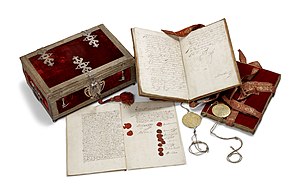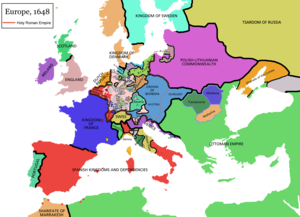Peace of Münster
| History of the Netherlands |
|---|
 |

The Peace of Münster was a treaty between the Lords States General of the Seven United Netherlands[a] and the Spanish Crown, the terms of which were agreed on 30 January 1648.[1] The treaty, part of the Peace of Westphalia, is a key event in Dutch history, marking the formal recognition of the independent Dutch Republic and the end of the Thirty Years' War and the Eighty Years' War.
Background
Lua error in Module:TNT at line 169: Dataset c:Data:I18n/Module:Excerpt.tab is not valid.
Negotiations
Negotiations between began in 1641 in the towns of Münster and Osnabrück, in present-day Germany. With the initiation of Spanish-Dutch peace talks, Dutch trade with the Levant and the Iberian Peninsula began to flourish. Dutch merchants, benefiting from both the availability of relatively cheap shipping and the cessation of hostilities, soon dominated the markets that had been previously dominated by English traders. Dutch merchants would also benefit from the foreign upheavals of the English Civil War and gain on English trade in their American colonies.[2]
While Spain did not recognise the Dutch Republic, it agreed that the Lords States General of the United Netherlands was 'sovereign' and could participate in the peace talks. In January 1646, eight Dutch representatives arrived in Münster to begin negotiations; these included two delegates from Holland with one each from the other six provinces. The Spanish envoys had been given great authority by the Spanish King Philip IV who had been suing for peace for years.[citation needed]
Start of peace negotiations
Lua error in Module:TNT at line 169: Dataset c:Data:I18n/Module:Excerpt.tab is not valid.
Spain's disadvantage
Lua error in Module:TNT at line 169: Dataset c:Data:I18n/Module:Excerpt.tab is not valid.
Outcome
On 30 January 1648, the parties reached agreement and the text sent to the Hague and Madrid for approval; it was ratified by the Spanish and Dutch delegations on 15 May, with the States General narrowly approving the Treaty on 5 June 1648.[3]
Despite achieving independence, there was considerable opposition to the Treaty within the States General since it allowed Spain to retain the Southern Provinces and permitted religious toleration for Catholics. Support from the powerful province of Holland meant it was narrowly approved but these differences resulted in political conflict.[3]
Contents
During the peace talks, negotiators representing the Republic and Spain reached an agreement relatively quickly.[4] The text of the Twelve Years' Truce was taken as the foundation, and this made it a lot easier to formulate the peace treaty, because many articles could be copied without too many changes.[4] If one compares the texts of the Twelve Years' Truce of 1609 to the Peace of Münster of 1648, the articles that correspond in whole or in part are as follows::[5]
| Twelve Years' Truce (1609) | Art. 1 | 2 | 3 | 4 | 5 | 6 | 7 | 8 | 9 | 10/11 | 12 | 13 | 14 | 15 | 16 | 17 | 18 | 19 | 20 | 21 | 22 | 23 | 24 | 25 | 26 | 27 | 28 | 29 | 30 | 31 | 32 | 33 | 34 | 36 | 37 | 38 |
| Peace of Münster (1648) | Art. 1 | 2 | 3 | 4 | 5 | 7 | 8 | 17 | 20 | 22 | 23 | 24 | 25 | 31 | 32 | 33 | 34 | 42 | 43 | 46 | 47 | 48 | 51 | 54 | 55 | 56 | 57 | 58 | 59 | 60 | 61 | 62 | 63 | 75 | 77 | 79 |

The States-General of the Dutch Republic were formally recognised by Spain as a sovereign entity. This important concession by Spain was therefore the first point; Spain stopped regarding the Republic's inhabitants as rebellious Spanish subjects (which it had done for 100 years). Peace seemed near. France, with which the Republic had agreed to come to a joint treaty with Spain, threw a spanner in the works by constantly coming up with new demands. The States then decided to conclude a separate peace with Spain without France.[6] On 30 January 1648, the peace text was adopted in four copies, two in French and two in Dutch.[6] The Utrecht delegate Nederhorst initially refused to put down his signature and seal, but after being forced to do so by his province, he put them on 30 April (although they no longer fit neatly on the document).[6] Then the documents were sent to The Hague and Madrid for ratification.[6] On 15 May 1648, the peace was definitively signed and solemnly ratified with an oath by Dutch and Spanish envoys, while a huge crowd was spectating the proceedings from the sidelines.[6]
In the Netherlands, the National Archives in The Hague keeps two copies of the Peace of Münster, a Dutch-language one ("NL-HaNA 1.01.02 12588.55B"), and a Francophone version ("NL-HaNA 1.01.02 12588.55C").[7] Both versions are provided by the Spanish side with French-language ratifications, both signed by King Philip IV – one in Spanish with Yo el Rey ("I the King"), the other in French with Philippe ("Philip") – and both bearing his seal in solid gold.[7][8]: 12–13 They are on display in the archive's exhibition room.[7] The Archivo General de Simancas in Spain preserves the other Dutch-language copy ("ES.47161.AGS//EST,LEG,2943,27") and the other French-language copy ("ES.47161.AGS//EST,LEG,2943,28").[9]
Further developments

Lua error in Module:TNT at line 169: Dataset c:Data:I18n/Module:Excerpt.tab is not valid.
See also
Explanatory footnotes
- ^ The Treaty does not use the word Republic but instead recognizes the Lords States General as sovereign.
References
- ^ 1648 Treaty of Munster. Rijks Museum/
- ^ Gijs Rommelse, "The Role of Mercantilism in Anglo-Dutch political relations, 1650–74", p. 596. Economic History Review, New Series, Vol. 63, No. 3 (August 2010), pp. 591–611. JSTOR 40929818.
- ^ a b "The Treaty of Münster, 1648" (PDF). University of Massachusetts. Archived from the original (PDF) on 13 July 2019.
- ^ a b Groenveld 2009, p. 142.
- ^ Groenveld 2009, p. 154.
- ^ a b c d e Groenveld 2009, p. 146.
- ^ a b c "Eindelijk vrede (1648)". Nationaal Archief (in Dutch). Retrieved 9 July 2022.
- ^ "Topstukken in perspectief Nationaal Archief". Issuu. 27 March 2019. Retrieved 9 July 2022.
- ^ "EST,LEG,2943,27 - Treaty of peace between Spain and The Netherlands". PARES. Retrieved 9 July 2022.
Bibliography
- Boer, H. W. J. de, H. Bruch en H. Krol (red.) Adriaan Pauw (1585–1653); staatsman en ambachtsheer. Heemstede, VOHB, 1985
- Groenveld, Simon (2009). Unie – Bestand – Vrede. Drie fundamentele wetten van de Republiek der Verenigde Nederlanden. Hilversum: Uitgeverij Verloren. p. 200. ISBN 9789087041274. (in cooperation with H.L.Ph. Leeuwenberg and H.B. van der Weel)
- Manzano Baena, Laura (Winter 2007), "Negotiating Sovereignty: The Peace Treaty of Münster, 1648", History of Political Thought, Volume 28, Number 4, pp. 617–641. JSTOR 26222899.
- Poelhekke, J. J. De vrede van Munster. 's-Gravenhage, Martinus Nijhoff, 1948.
External links
- Scans from the National Archives (The Hague) of the Dutch-language version (12588.55B) of the Peace of Münster
- Scans from the National Archives (The Hague) of the French-language version (12588.55C) of the Peace of Münster
- Printed Latin and German translations of the original text of the Peace of Münster (30 January 1648)
- Tratado de Münster (1648) en español – Modern Spanish version
- Pages with script errors
- CS1 Dutch-language sources (nl)
- Articles with short description
- Short description with empty Wikidata description
- All articles with unsourced statements
- Articles with unsourced statements from July 2022
- AC with 0 elements
- 1648 in the Holy Roman Empire
- Treaties of the Dutch Republic
- Peace treaties of Spain
- 1648 in the Dutch Republic
- 1648 treaties
- 1648 in Spain
- History of Münster
- Eighty Years' War (1621–1648)
- 1648 in Europe
- Dutch Republic–Spain relations
- Thirty Years' War treaties

